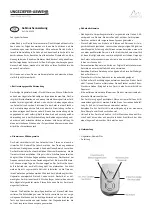
8
3.5 Reset button and ON-OFF-AUTO selector switch
Parallel operation with 3 float switches, pages 23 and 24.
4. Systems for parallel operation with 4 float
switches
Description (see also page 25 or 26):
The pumps are controlled by the liquid level in the pit.
• The float switch, pos. 2, starts the first pump.
• The float switch, pos. 3, starts the next pump.
• The float switch, pos. 1, stops both pumps after expiration of
the "stop delay" (can be set).
• The pumps operate alternately.
• The top float switch, pos. 4, activates the high-level alarm.
4.1 Electrical connection
Parallel operation with 4 float switches, pages 25 and 26.
The figures show all electrical connections required to connect
the LCD 108 for
direct-on-line starting, parallel operation with
4 float switches
.
Fig. B2 on page 26.
The figure shows all electrical connections required to connect
the LCD 108 for
star-delta starting, parallel operation with 4 float
switches
.
The operating voltage and frequency are marked on the controller
nameplate. Make sure that the controller is suitable for the
electricity supply on which it will be used.
All cables/wires must be fitted through the Pg cable entries and
gaskets (IP 65).
Maximum back-up fuse is stated on the controller nameplate.
If required according to local regulations, an external mains
switch must be installed.
Note:
If the PTC resistance/thermal switch of the motor is
connected, the factory-fitted short-circuit jumper must be
removed
(terminals T11-T21, T12-T22). For correct installation of
PTC resistor/thermal switch, see the installation and operating
instructions of the pump.
Single-phase motors must be connected to an external operating
capacitor and in certain cases also to a starting capacitor. Further
details can be found in the installation and operating instructions
for the pump in question.
The
reset button
is a push-button for manual resetting of alarm signals to
external
alarm devices and the built-in
buzzer (i.e.
not
for resetting of the alarm memory as this is reset by means of the ON-OFF-AUTO selector switch,
see position OFF
( )).
Even if the fault condition still exists, the
external
alarm devices and the built-in buzzer will be reset when the reset
button is pressed.
The
ON-OFF-AUTO selector switch
for each pump has three different positions:
ON ( )
, top position:
• The pump will start when the selector switch is pushed into this position (unless the motor protection relay has cut
out the pump).
• If the PTC resistance/thermal switch of the motor registers overtemperature, the pump will
not
be switched off.
Note:
It is the user’s responsibility to decide how long the pump is to run with this fault indication. Over a long
period, the pump will be damaged!
In explosion hazard areas, switch 10 of the DIP switch
must
be set as stated in section
. Consequently,
the pump
cannot
be started when the PTC resistance/thermal switch of the motor registers overtemperature.
OFF (
)
, middle position:
• The pump
cannot
start when the selector switch has been set to this position.
• The alarm memory is reset by pushing the selector switch into position OFF
( ). The alarm memory is the light
indication of a fault condition which has disappeared. If a fault condition still exists when the selector switch is
pushed into position ON ( ) or AUTO ( ), the alarm indication will be repeated immediately.
AUTO (
)
, bottom position:
• The pump is controlled by the input signals from the float switches and the pump according to the selected
DIP switch setting.
• Alarm signals will automatically be reset. Switch 9 of the DIP switch can, however, be set to manual resetting
which is carried out by means of the reset button, see section
.
• The pump will restart automatically when a given fault condition disappears. However, this is dependent on the
setting of switch 10 of the DIP switch, see section
• When the pump starts automatically after a fault condition which has disappeared, the indicator light will continue
to show the fault condition (alarm memory) and the indication can only be removed by resetting the alarm memory,
see position OFF
( ).
2
1
Before starting any work on pumps used to pump
liquids which could be constituted as being
hazardous to health, thorough cleaning/venting of
pumps, pits, etc. must be carried out according to
local regulations.
Before making any connections in the LCD 108 or
work on pumps, pits, etc., it must be ensured that the
electricity supply has been switched off and that it
cannot be accidentally switched on.
Before starting work on the system, switch off the
supply voltage and lock the mains switch in
position 0.
Any external voltage connected to the system must
be switched off before work is started.
The LCD 108 must be connected in accordance with
the rules and standards in force for the application in
question.
Float switches placed in an explosion hazard area
must be connected via an EEx barrier, e.g. Grundfos
number 96440300.
The EEx barrier
must not
be installed in the explosion
hazard area.
Equipment used in explosion hazard areas
must
in
each individual case have been approved for this
particular application. Furthermore, the cables into
the explosion hazard area
must
be laid in accordance
with local regulations.









































